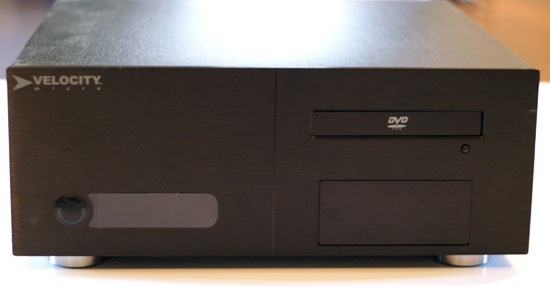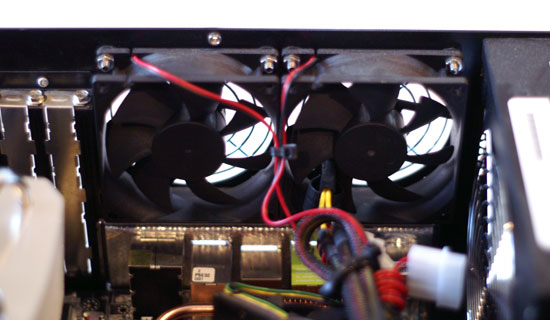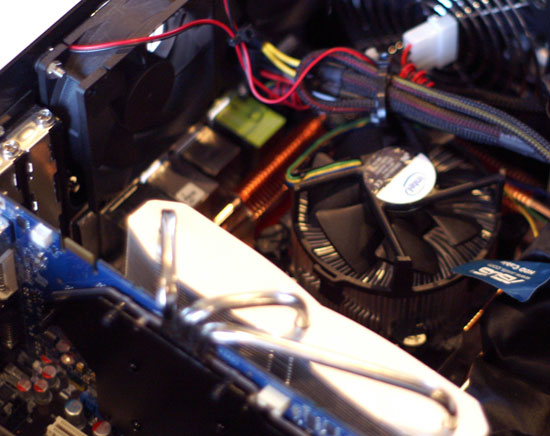Sparkle 8800 GT Passive: The Fastest Silent GPU in the World
by Anand Lal Shimpi on November 29, 2007 12:00 AM EST- Posted in
- GPUs
Getting it Going
Remember my skepticism from earlier? I was so eager to find out if this thing worked that I threw it into our Core 2 Extreme QX9770 testbed which was already setup and ready to accept such a thermally defiant graphics card.
Surprisingly enough, it worked. In working on the 8800 GT roundup I quickly discovered that Crysis was an excellent overclocking/thermal test. It turns out that a number of early overclocked 8800 GT boards were either overclocked too far or didn't have their fans set to come on early enough, resulting in a lot of crashing and general unpleasantness. What's most interesting is that these cards would complete our Oblivion and Bioshock tests without a problem, but just firing up Crysis and trying to change resolutions was enough to lock up the entire system. Thus Crysis would be the perfect game to stress test the passively cooled Sparkle.
The G92 GPU temperature maxed out at around 102C (215.6F), which is amazingly hot. The heatsink itself grew hotter than anything we remember ever touching outside of a kitchen. We had to do a sanity check and look up the burning point of paper just to make sure we weren't creating a fire hazard by running this thing.

This temp comes from our next test...
Surprisingly enough, the system remained stable and we continued to play Crysis and run through our normal gaming benchmarks without a hitch. However, we had no idea if the 8800 GT Passive would hold up under a more real-world scenario: inside a case.
Making it Hot
We did have an ulterior motive for pairing the Sparkle 8800 GT Passive with our QX9770 test bed, we wanted to toss it in a case with the hottest, fastest Intel processor we had.

We gutted a nearby Velocity Micro HTPC and swapped in our ASUS P5E3 Deluxe (X38) motherboard and QX9770. If you're not familiar with the QX9770, it's a quad-core 3.2GHz Penryn/Yorkfield based processor that won't be out until early 2008. It's got a TDP of 135W and manages to get quite warm, so putting it three inches away from the Sparkle's fanless heatsink just seemed like a great idea.
We also threw in a 150GB Western Digital Raptor hard drive, we could've gone with something cooler but where's the fun in that?

The chassis has two 80mm case fans in the back above the CPU and we tested with them both on and off. The Seasonic SS-700HM PSU has two fans of its own, so running the system without any extra case fans wouldn't be a huge deal.













55 Comments
View All Comments
natrap - Saturday, December 1, 2007 - link
I agree with Cerb. The fact that it reached 111C and did not fail is a good sign. And that was recorded with the case fans off in a poorly ventilated case. I'm gonna get this for an Antec Solo which has a single 120mm case fan at the rear over the CPU. I'd expect a temp a little lower. As for such high temps affecting the life of the card, well it does come with a 12 month warranty. If it hasn't failed in that time running close to 24/7 then the chance of it failing soon after isn't going to be a great deal higher.natrap - Saturday, December 1, 2007 - link
I agree with Cerb. The fact that it reached 111C and did not fail is a good sign. And that was recorded with the case fans off in a poorly ventilated case. I'm gonna get this for an Antec Solo which has a single 120mm case fan at the rear over the CPU. I'd expect a temp a little lower. As for such high temps affecting the life of the card, well it does come with a 12 month warranty. If it hasn't failed in that time running close to 24/7 then the chance of it failing soon after isn't going to be a great deal higher.Allen Iverson - Saturday, December 1, 2007 - link
Great article anand, LOVE the Sparkle thumbnail :Dgochichi - Friday, November 30, 2007 - link
A lack of HDMI for this type of card is simply unacceptable.I wish the heat pipes wrapped further down, and in general, fan-less cards such as these (the ones that perform) should come with the option of adding standard two 80mm or one 120mm fans. The heat sink needs to be more impressive.
I have (though I don't use it anymore) a fan-less X800, and while it was marginally fine for a while to use it fan-less, I used to lay a quiet 80mm on top of it... I wish I could have easily secured the fan.
You see, fan less cards are meant for the few, the people that want more options. The price could easily be $350.00 if the card was right, and it be THE card to own for the enthusiast. You could down clock the card and slap it into a poorly ventilated case, or you could slap two 80mm fans on it and overclock it more than any other.
That's my two cents. To me, this is no good... if you care about quietness, it would be better to buy a regular card that self-cools... b/c leaving it up to the case means multiplying the noise.
harpoza - Friday, November 30, 2007 - link
Next day shipping almost always costs $30-$50. I'm not sure why this is so notable?Bozo Galora - Friday, November 30, 2007 - link
Or, you could have run the card at 54 degrees under load by using the new Thermalright HR-03GT GPU HS with 92mm Fan.http://forums.vr-zone.com/showthread.php?t=208305">http://forums.vr-zone.com/showthread.php?t=208305
You still could even amend this article with same, or even do a new one in cases cooling. Then you would have both ends of the spectrum.
And, supposedly, according to one report on the web, the 8800GT was not a paper launch, but some components needed for the board were in short supply. "Nvidia declined to say which ones".
kilroy0097 - Friday, November 30, 2007 - link
My point being, after looking at this review and testing of the Sparkle version of the 8800GT, it seems to me to be an added cost for less than adequate benefit. Perhaps you won't be using the card to play games like Crysis at full break to see how hot it can get and for those people this will probably be just fine. However for those that want silence and power wouldn't it be better to get a stock 8800GT, the cheapest you can find and then put on a Thermalright HR-03 Passive VGA cooler that is made for Nvidia 8800 cards. It achieves the same thing as Sparkle's design except it's made to better dissipate the heat. Granted it costs around $50 but it's also larger and more efficient. I think personally it's a safer and better alternative than the Sparkle design. Though kudos to Sparkle for at least attempting.scottb75 - Friday, November 30, 2007 - link
What kind of computer case (if any) was used for this test? Because my EVGA 8800GT SC at stock (SC) clocks and stock fan speeds runs about 57C idle and 78C at load. If you are getting 72C idle and 94C at load on a stock 8800GT something is wrong.stapuft - Friday, November 30, 2007 - link
Agreed, mine runs 52/72C on Crysis, fan at 35%. 56/78 stock.The story in Anand's blog about failing 8800GT's and 3870's would make sense if they had cooling problem. Pics of the test rig and ambient temperatures in the office at time of test are called for.
BTW, if you're in a hurry, you deserve a high price for shipping. Lose the rant about it. EVGA is a standup company.
stapuft - Friday, November 30, 2007 - link
Agreed, mine runs 52/72C on Crysis, fan at 35%. 56/78 stock.The story in Anand's blog about failing 8800GT's and 3870's would make sense if they had cooling problem. Pics of the test rig and ambient temperatures in the office at time of test are called for.
BTW, if you're in a hurry, you deserve a high price for shipping. Lose the rant about it. EVGA is a standup company.